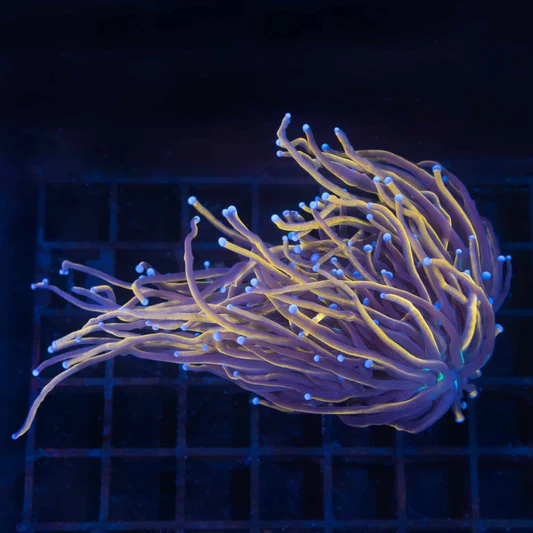Torch Coral (Euphyllia glabrescens)
• Common Name: Torch Coral
• Scientific Name: Euphyllia glabrescens
• Class: Anthozoa
• Origin: Indo-Pacific, Australia, Indonesia, Fiji
• Category: LPS (Large Polyp Stony Coral)
• Care Level: Intermediate
• Temperament: Aggressive (long sweeper tentacles)
• Lighting: Medium (PAR 100-200)
• Flow: Moderate to High (gentle but consistent)
• Placement: Middle to Bottom
• Growth Rate: Moderate
Overview:
The Torch Coral (Euphyllia glabrescens) is one of the most iconic and sought-after LPS corals due to its long, flowing tentacles that move beautifully with the water’s flow. It is a close relative of Hammer and Frogspawn corals but has much longer tentacles, making it one of the most visually dynamic corals in the reef aquarium hobby.
Torch corals come in a wide range of colors, from neon green to gold, and even rare “Holy Grail” and “Dragon Soul” varieties. However, they require stable water conditions and careful placement due to their long sweeper tentacles, which can sting neighboring corals.
Tank Requirements & Water Parameters:
To thrive, Torch Corals need stable parameters similar to other LPS corals:
• Temperature: 76-80°F (24-27°C)
• pH: 8.1-8.4
• Salinity: 1.024-1.026 SG
• Alkalinity: 8-10 dKH
• Calcium: 400-450 ppm
• Magnesium: 1250-1350 ppm
• Nitrate: 5-15 ppm (prefers moderate nutrients)
• Phosphate: 0.03-0.1 ppm
While Torch Corals can tolerate slightly higher nutrients, they do not do well in ultra-low nutrient systems (ULNS). Maintaining some nitrate and phosphate prevents tissue recession and fading.
Lighting Needs:
Torch Corals prefer moderate lighting (PAR 100-200).
• Too much light can cause bleaching and retraction.
• Too little light can lead to slow growth and loss of fluorescence.
• Adjust placement gradually if moving from low to high light to prevent stress.
Flow Requirements:
• Moderate to high, indirect flow is best.
• Torch Corals do not like direct blasts of flow, which can cause tentacle damage or retraction.
• Gentle, random flow mimicking natural reef conditions is ideal (use gyre or wave pumps).
Feeding & Nutrition:
Torch Corals contain zooxanthellae for photosynthesis, but they benefit greatly from target feeding:
• Ideal Foods:
• Mysis shrimp
• Brine shrimp
• Reef Frenzy, Benepets, or Coral Frenzy
• Powdered coral foods (e.g., Reef Roids)
• Feeding Frequency: 1-2 times per week for better growth and polyp extension.
Target feeding at night or during polyp extension allows for better food capture.
Placement & Aggression:
• Placement: Middle to bottom with at least 6-8 inches of space from other corals.
• Aggression: Highly aggressive—Torch Corals have long sweeper tentacles (up to 6 inches!) that can sting and damage neighboring corals.
• Best tankmates: Other Euphyllia species like Hammer or Frogspawn corals can sometimes coexist in a “Euphyllia Garden.”
Growth & Propagation:
Torch Corals grow moderately fast compared to other LPS corals. They reproduce by budding new heads over time.
Fragging Torch Coral:
• Use bone cutters or a bandsaw to carefully cut between branches.
• Allow frags to heal in low-flow areas before reintroducing them into the display tank.
Tip: Keep an eye on skeleton growth—damaged skeletons can lead to Brown Jelly Disease, a fast-spreading bacterial infection.
Popular Color Morphs & Variations:
Torch Corals come in a variety of vibrant colors, including:
• Green Torch – Classic neon green tentacles with purple tips
• Gold Torch – Bright golden-yellow tentacles with blue tips
• Dragon Soul Torch – Deep orange and gold hues with a purple base
• Holy Grail Torch – Neon green, gold, and purple with fluorescent tips
• Purple Torch – Dark purple tentacles with contrasting light tip
• New York Knicks- Dark base with gold/orange polyps and blue tips
Challenges & Common Issues:
• Tissue recession: Usually caused by unstable alkalinity, low nutrients, or physical damage.
• Brown Jelly Disease: A bacterial infection that causes rapid tissue necrosis—remove affected heads immediately to prevent tank-wide spread.
• Too much or too little flow: Excess flow leads to tentacle damage, while too little leads to debris accumulation.
• Burnt tips: Often caused by alkalinity swings or nutrient imbalances—ensure stable water chemistry.
